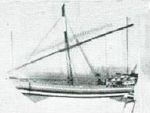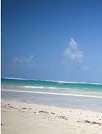
Have you ever wondered what the name of the capital city of Somalia, Mogadishu, meant? Somalia has been in the news in recent decades, particularly after the humiliation the American army received with Operation Restore Hope in 1993 at the hand of the local proclaimed president-to-be Mohamed Farrah Aidid, and also because of pirates roaming its coasts in the 2000s. The movie Black Hawk Down shows part of this operation with the ensuing Battle of Mogadishu, while Captain Phillips focuses on pirates.
The city of Mogadishu is located on the Indian Ocean coast of the Horn of Africa, in the Banaadir administrative region (gobol) in southeastern Somalia. The name Mogadishu is said to come from the Persian word Maq’ad-i-Shah, which means “the seat of the Shah.” This is a reflection of the city’s early Persian influence. Locally, it is spelled Muqdisho. To locals, the city is also known as Xamar.

So where does the Persian influence stem from in a city on the horn of Africa? Well, for starters, the city was founded in the 10th century by Arab traders. However, 2500 years old relics and pictographs were found on rocks in northern Somalia attesting to the area’s ancient occupation. Tradition and old records assert that southern Somalia, including the Mogadishu area, was inhabited in early historic times by hunter-gatherers of Khoisan descent who were later either driven out of the region, or assimilated by other migrants in the area.

In 1331, the Moroccan explorer Ibn Battuta visited the city when it was at its zenith. He described Mogadishu as “an exceedingly large city” with many rich merchants, which was famous for the high quality fabric that it exported to destinations including Egypt. Batutta added that the city was ruled by a Somali Sultan, Abu Bakr ibn Sayx ‘Umar, who was originally from Berbera in northern Somalia and spoke both Somali (referred to by Battuta as Mogadishan, the Benadir dialect of Somali) and Arabic with equal fluency. The Sultan also had a retinue of wazirs (ministers), legal experts, commanders, royal eunuchs, and other officials at his service.
There appears to have been a strong Persian presence in both Mogadishu and Zeila for a time. A Shi’a influence can still be seen in some areas, as in the southern Somalia veneration of Fatimah, the Prophet Muhammad‘s daughter. Moreover, in the olden days, the city’s textiles were forwarded far and wide throughout the interior of the continent, as well as to the Arabian peninsula and as far as the Persian coast.

The Chinese navigator Zheng He visited the region with his expedition from 1413 to 1415. From the 13th to the 15th centuries, Mogadishu was an important city of the Ajuran Sultanate. The city was governed by the Muzzaffar dynasty. Mogadishu is one of the rare cities on the East coast of Africa which was never conquered by the Portuguese whose attempts to occupy the city failed in the 16th century. However, the Muzzaffar dynasty lost control of the city to the Hawiye Somali when the Ajuran sultanate was defeated in the 17th century.
By 1892, Mogadishu was under the joint control of the Somali Sultanate of the Geledi and the Omani Sultanate of Zanzibar. The Geledi Sultans were at the height of their power. They dominated the southern ivory trade, and also held sway over the Jubba and Shebelle valleys in the hinterland.
In 1905, Italy made Mogadishu the capital of the newly established Italian Somaliland. The Italians subsequently referred to the city as Mogadiscio. After World War I, the surrounding territory came under Italian control with some resistance. Thousands of Italians settled in Mogadishu and founded small manufacturing companies. They also developed some agricultural areas in the south near the capital, such as Janale and the Villaggio duca degli Abruzzi (present-day Jowhar). In the 1930s, new buildings and avenues were built. A 114 km (71 mi) narrow-gauge railway was laid from Mogadishu to Jowhar. An asphalted road, the Strada Imperiale, was also constructed and intended to link Mogadishu to Addis Ababa.

British Somaliland became independent on 26 June 1960 as the State of Somaliland, and the Trust Territory of Somalia (the former Italian Somaliland) followed suit five days later. On 1 July 1960, the two territories united to form the Somali Republic, with Mogadishu serving as the nation’s capital.
In 1990, Mogadishu fell under the control of rebels who forced President Mohamed Siad Barre into exile. The rebels formed rival factions each recognizing different presidents, and civil war broke out. In 1992, the United Nations sent armed forces led by American forces. After deadly combats, the American forces were defeated and forced to run away by Aidid‘s troops.

Today, the amazing sandy beaches of Mogadishu with its vibrant coral reefs are prime land for tourist resorts. Since the city’s pacification on 2011, the city is slowly rebuilding, and establishing international trades with other cities and countries. Mogadishu traditionally served as a commercial and financial centre. Mogadishu’s economy has grown rapidly since then. The Port of Mogadishu is the official seaport of Mogadishu, and the largest harbour in the country. Please enjoy this vibrant, reviving, and historical city. Do check out Somaliagenda.com for amazing pictures of Mogadishu and its people.


Nice write-up on Mogadishu. I didn’t know there was a Persian influence in the name and history. Interestingly enough in America, there’s a big Somalian population in the Twin Cities (Minneapolis and St. Paul) region in Minnesota. There’s even a neighborhood in Minneapolis called Little Mogadishu.
LikeLike
Yes… there is a big Somali population in the Twin cities. I didn’t know about Minneapolis’ neighborhood known as Little Mogadishu. Have you visited it?
LikeLiked by 1 person
Definitely, and I’ve wondered how that came to be in the Twin City region. The weather in MN certainly isn’t like Somalia, that’s for sure. I’ve been to the Twin Cities multiple times, but I’ve never been to that neighborhood before. I do have family in MN and my dad was born in Minneapolis.
LikeLike
Thanks for sharing
LikeLiked by 1 person
No problem. 🙂
LikeLike
Pingback: සෝමාලි කතා ~ III කොටස – කණ්ඩාගේ කොලම ~ Kanda's Column